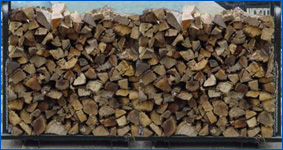How much is a face cord of firewood?
How long does a face cord of firewood last?
How should I store and stack my firewood?
How much firewood should be stored indoors?
How long should wood sit before it is ready to be burned?
What is the best way to build a fire in a fireplace?
How do I keep my chimney working well?
How much is a “face cord” of firewood?
What is a “full cord” of firewood?
- A face cord (or F/C) of firewood = 4 feet high by 8 feet long by 16 inches deep. (4′ x 8′ x 16″)
- There are approximately 220-240 pieces in a face cord of firewood.
- 3 “face cords” of firewood = 1 “full cord” of firewood.
- We sell by 1/2 or whole face cords.
|
|
|
How long does a face cord of firewood last?
If you burn 1-2 fires per week, a face cord of firewood should last the season. If you burn more than that you can double or triple the face cords.
How should I store and stack my firewood?
- Stack your firewood with a supporting base at least 2-3 inches off the ground.
- The greater the amount of area exposed to the air, the more rapid the drying process.
- Store your firewood outdoors under partial protection, covering top half of stack with a tarp and leaving the bottom half open for airflow. If you choose to store firewood inside a garage or other shelter, make sure the wood is dry from any elements.
How much firewood should be stored indoors?
In cold seasons, a two to three day supply of firewood should be kept indoors. Cold wood brought in from outside will cool the fire too much and make it less efficient.
How long should wood sit before it is ready to be burned?
The sap in seasoned wood has dried up. Unseasoned, or green, wood won’t burn well (if at all) because it is too wet. If the wood is extremely heavy and has sap oozing out of it, it’s too early to burn. Wood takes from six months to a year to season; most wood being sold now was cut last spring. To tell whether wood is seasoned, knock two logs together. Well-seasoned logs make a sharp ringing sound. Well-seasoned logs will be cracked on the ends, not be reddish or golden in color and not have a woody smell.
What is the best way to build a fire in a fireplace?
A fire constructed with perfect form and bone-dry materials will still fizzle out if you don’t understand the role of the flue. The flue is the channel inside the chimney or stovepipe that circulates air and creates a draft, thus feeding the necessary oxygen to the fire.
The flue is kind of a valve or doorway that opens or shuts off the air flow though the chimney, known as the damper. A handle opens and closes it, and that’s usually located in the fireplace near the bottom of the chimney. For wood stoves, there’s usually a handle located on the side of the stove, towards the top and at the back. Take a flashlight and familiarize yourself with the operation of your damper– and the position of it’s handle or chain when it’s closed or open. This will prevent the unnecessary smoke-outs and beeping smoke detectors that inevitable follow careless damper operation. Once you know the operation of your flue and damper, it’s time to build a fire.
There are three steps to building a fire and certain materials that you need. The three steps are preparing the materials, setting up the fire (building a fire), and lighting and maintaining the fire. The necessities for building a successful fire are 4 to 7 sheets of newspaper, two to three handfuls of dry kindling about an inch thick and 12-18 inches long, 4 to 5 logs of firewood that have been split and seasoned, long wooden matches or a butane lighter, and a fireplace screen. Place the sheets of newspaper in the center of your fireplace grate. Place the kindling on top of and around the newspaper, leaving enough room for the newspaper to receive oxygen.
Then place two of the big logs on either side of the newspaper and kindling structure. Then just use your matches to light the newspaper and the kindling should start right up. Keep an eye on it to make sure it doesn’t go out and make sure that the big logs start burning. When that happens just relax and enjoy your blaze.
How do I keep my chimney working well?
The chimney is very important to an efficiently burning heat source in your home. For optimal results it should be cleaned annually. Burning wood that is not receiving adequate air flow from the chimney flue, or wood that is too wet, results in the production and build up of unburned gasses called creosote. Creosote is sticky and highly flammable and should be cleaned out regularly to reduce the risk of chimney fires.






